I’m on vacation this week in Palm Desert, California – part of an annual ritual that I’ve enjoyed for about 30 years. Nearly the first thing I do while I’m down here is get away from the golf courses and shopping malls into the high desert mountains. Yesterday my daughter and I hiked Horsethief Creek trail (great name, huh?) in the San Bernardino Wilderness and admired the spring flowers that are just starting to emerge.
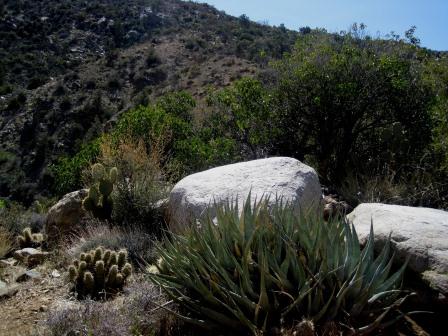
One half of my brain was busy noticing all of the native plants that I felt had great ornamental value for home landscapes, while the other half worried about what to do for my blog posting this week. And finally both sides of my brain got together for a chat and here we are with today’s posting.
For many years, the home landscapes down here were primarily of the petunias-and-palms persuasion (or in this case snapdragons and olive trees).
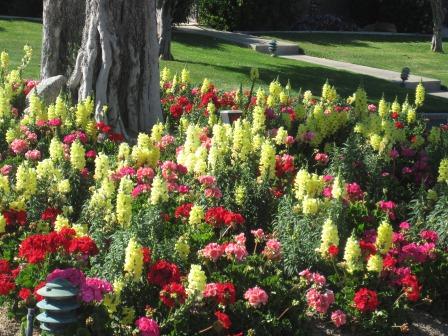
That’s been changing as water has become more limited (i.e., more expensive) and people’s appreciation of native plants has increased. Still, an awful lot of native landscapes rely on traditional desert plants like barrel cacti or agave. They’re pretty – but predictable. And the results are often not natural looking.
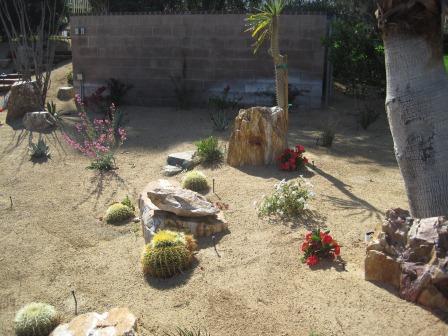
So…why not shake things up a bit by using some lesser known, but nonetheless stunning species? While many nurseries might not carry these, the only way to change that is to request them. Savvy nurseries respond to customer requests. Or check with native plant societies, who often have plant sales featuring unusual native species.
Without further ado, here are some great plants from yesterday’s hike, which tolerate low water conditions but have great ornamental and/or functional value.
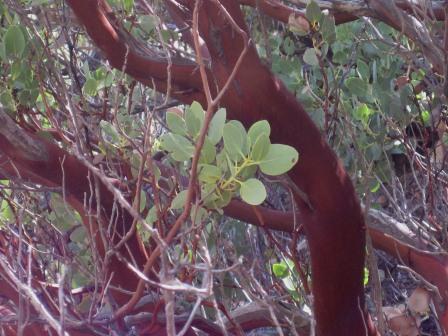
Arctostaphylos glauca (manzanita) – deceptively tough green leaves against a red-striped bark
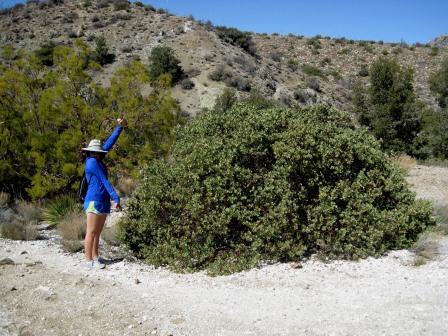 The lovely Charlotte displays a good-sized manzanita
The lovely Charlotte displays a good-sized manzanita
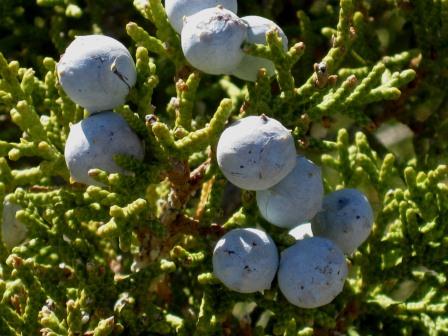 Juniperus californica (California juniper) – because every desert landscape needs its own gin mill
Juniperus californica (California juniper) – because every desert landscape needs its own gin mill
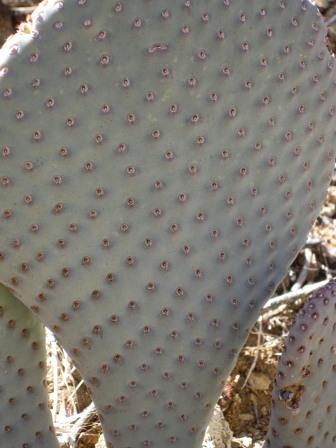 Opuntia basilaris (beavertail cactus) – the symmetrical arrangement of tiny spines is aesthetically appealing
Opuntia basilaris (beavertail cactus) – the symmetrical arrangement of tiny spines is aesthetically appealing
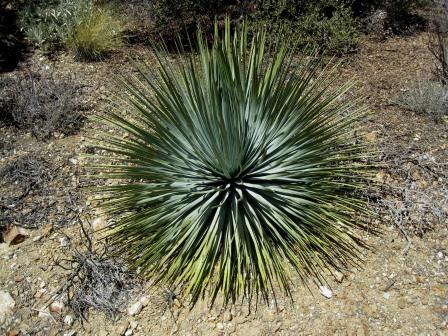
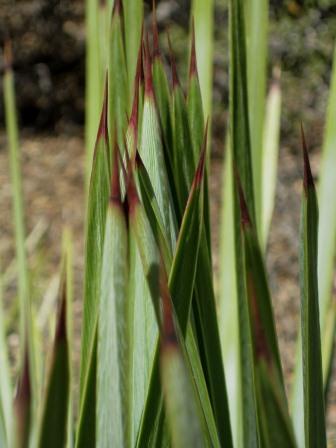
Nolina parryi (Parry’s beargrass) – absolutely stunning plant with wickedly sharp leaves
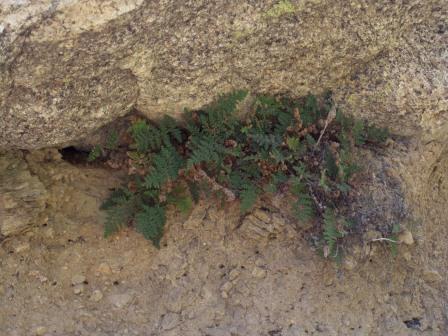 Pentagramma triangularis (goldenback fern) – yes, you can even find ferns in the desert
Pentagramma triangularis (goldenback fern) – yes, you can even find ferns in the desert


Astragalus spp. (vetch) – sturdy groundcover with brilliant purple flowers. And it fixes nitrogen!
(A final note: don’t dig these up in the wild and try to transplant them. It’s doubtful they would survive, and in many instances it’s illegal. Do the right thing – support your local native plant nursery and buy them legally.
Great topic for today Linda. These plants are right up my alley. Of course it a far distance cry from where I live at the moment. Burrrr, I just had to turn up the heat. One of the dangers of growing some plants native to the southwest is overwatering issues. Many western plants are adapted to that winter wet cold and dry summer heat, with the exception of course to those also adapted to a short two month monsoonal flow from Mexico. There’s a sort of flawed human reasoning that often fits any situation and that’s especially so in the case of watering plants and it goes like this – “If a little water is good, then more must be better.” For some of those plants it could mean their death. I’d post more but your comments software in the forum for whatever reason doesn’t exactly allow for proper paragraphs and other tools for logical coherency.
Well I don’t understand how I got a double post either, Oh well!!
Linda, Ilved 30 minutes from Palm desert on the other side of those Santa Rosa mountains where you hiked Horsethief Creek. The town is called Anza. Elevation is about 4000′. Try and visit the “Living Desert Museum” which is right there in Palm Desert if you can. They have great separate ecological habitat Botanical Gardens representing the different desert regions of the southwest. There are also several wild desert Oasis if you know where to look.
Kevin, you’re absolutely right about the water issue. You can water some xerophytic plants to death. And there are others that are water savers – they will take all you dish out, to the extent that you negate any water savings you were hoping to have.
I know exactly where you live, having been through there before (we visited the Salton Sea a few years ago – I did a post on it that you can find with the search function). We go to The Living Desert nearly every year, often hiking the Mt. Eisenhower loop and always going through the display gardens. In fact, that’s where we are heading today!
(On a technical note, you can make paragraphs by inserting hairpin brackets around the letters br. Do it twice to get white space between the paragraphs.)
I was born & raised in the humid South. Never understood what people found attractive about xeric plants, gardens etc. Lush was the only way to go in my book. Then I moved out to California, the land of dry summers and barely-damp winters. After more than 20 years here, I am now fully in love with plants like manzanita and opuntia and the landscapes they inhabit. How can you not love their form and color, not to mention their incredible resilience ?
I use juniper berries for a venison marinade. Recipe from a chef on the Food channel. My local gourmet shop stocks them. Made me think maybe my ancestors used them too.
Okay third time worked like a charm – LOL! Linda, if possible, try and visit The Coahchella Valley Preserve on the north side of I-10. I believe this is the 1000 Palms area. Here’s an interesting and important link to a successful restoration story that every ecosystem reclamation project can learn from. Let’s see if I can get this link to work using some other tools. A Success Story
Tamarisk Control at Coachella Valley Preserve, Southern California Well hopefully that worked. If not I’ll post it plainly below. There’s an important point in that article about plant restoration success on hand cleared acreage and the not so successful machine cleared acreage. As you may well observe down there, Tamarisk has been a horrible introduction for windbreak control. But it’s the portion of the article which deals with plant rehabilitation which was superior as a result of manually hand clearing which left the biological system underground intact as opposed to the mechanical clearing which destroyed that underground grid. This was one of my pet peaves up in Anza when Green Horn wannabe weekend Ranchers wanted the rural life once in a while. they’d hire some landclearing contractor Dude with heavy machinery to completely strip and then proceed to pile up the crushed debri on one end of their property. I’d try and talk folks into lightly hand removing various undesirable shrubs and other brush as they needed, but to immediately replace it with a more desirable tree or shrub, hopefully a beautiful native. In your photos above, you have some pics of Big Berry Manzanita. I’ve seen people carefully clear their land and leave those big beautiful Manzanitas only to have them suddenly die the following year. Some of those Manzanitas may actually be growing in shallow soil where bedrock or hard compressed decomposed Granite may have been close to the surface. The only thing that may have allowed them to thrive was that underground Mycorrhizal Internet Grid. When that was removed, then the small trees or shrubs became stressed and died. I’m going to address this further in a post on my blog, but that link above if it works proves some of my own experience in land restoration technics.